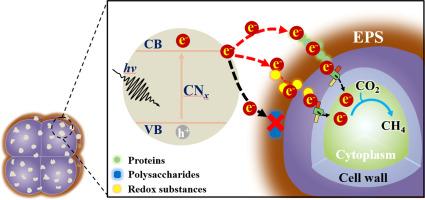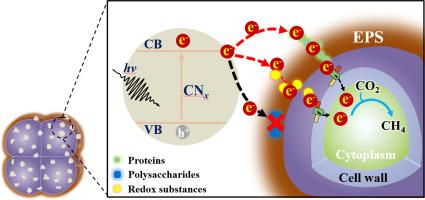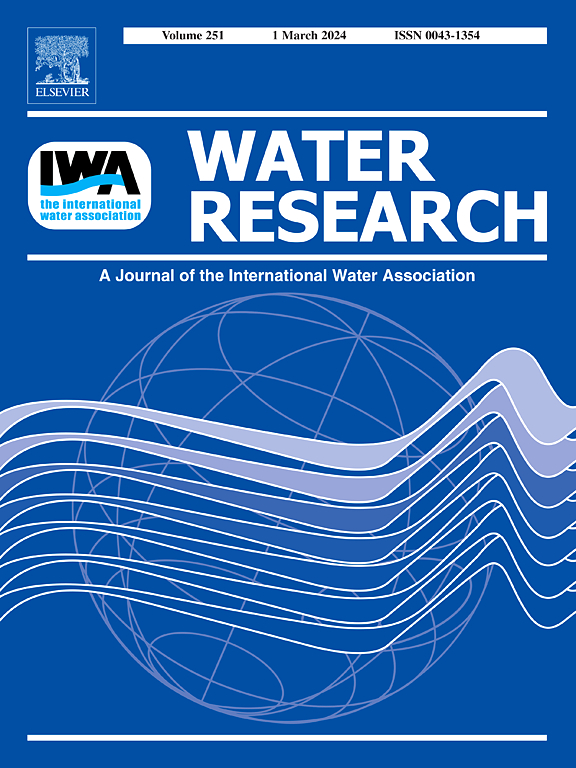Unlocking interfacial electron transfer in biophotoelectrochemical processes: Role of extracellular polymeric substances in aquatic environments
IF 12.4
1区 环境科学与生态学
Q1 ENGINEERING, ENVIRONMENTAL
引用次数: 0
Abstract
The biophotoelectrochemical process (BPECs) integrates the light-absorbing capabilities of nano-semiconductors with the catalytic efficiency of microorganisms, demonstrating significant potential for the development, utilization, transformation, and ecological restoration of water resources. In aquatic environments, extracellular polymeric substances (EPS) serve as a critical interfacial barrier between microorganisms and semiconductor materials, with the underlying electron transfer mechanisms playing a pivotal role in determining the efficiency of bio-photochemical reactions. Despite their importance, the rapidity and complexity of the electron transfer process within EPS pose significant challenges to a comprehensive understanding of BPECs. In this study, an in-situ characterization strategy was employed to rapidly and accurately analyze the components and pathways of photogenerated electron transfer involving EPS at interfaces. The findings indicate that EPS significantly accelerates the transfer of photogenerated electrons within BPECs. Specifically, proteins and redox-active substances within EPS act as efficient conduits for electron transfer, accounting for up to 84.2% of the increased speed in electron transfer rates at bio-abiotic interfaces. Conversely, polysaccharides within EPS impede the electron transfer process but serve as substrates that facilitate methane (CH4) production. The in-situ characterization approach used in this research provides valuable insights into the interfacial electron transfer mechanisms of EPS in BPECs, emphasizing their relevance in aquatic environments. This study establishes a theoretical framework for designing high-performance BPECs, with significant implications for the energy utilization of water resources and the transformation of water pollutants.


解锁生物光电化学过程中的界面电子转移:细胞外聚合物在水生环境中的作用
生物光电电化学(BPECs)将纳米半导体的吸光能力与微生物的催化效率相结合,在水资源的开发利用、转化和生态恢复方面具有重要的潜力。在水生环境中,细胞外聚合物(EPS)是微生物和半导体材料之间的关键界面屏障,其潜在的电子转移机制在决定生物光化学反应的效率方面起着关键作用。尽管它们很重要,但EPS内电子转移过程的快速性和复杂性对全面理解bpec构成了重大挑战。在本研究中,采用原位表征策略,快速准确地分析了界面处涉及EPS的光生电子转移的成分和途径。研究结果表明,EPS显著地加速了bpec内光生电子的转移。具体来说,EPS中的蛋白质和氧化还原活性物质是电子转移的有效通道,占生物-非生物界面电子转移速率增加的84.2%。相反,EPS中的多糖阻碍了电子转移过程,但作为促进甲烷(CH4)产生的底物。本研究中使用的原位表征方法为bpec中EPS的界面电子转移机制提供了有价值的见解,强调了它们在水生环境中的相关性。本研究建立了高性能bpec设计的理论框架,对水资源的能源利用和水污染物的转化具有重要意义。
本文章由计算机程序翻译,如有差异,请以英文原文为准。
求助全文
约1分钟内获得全文
求助全文
来源期刊

Water Research
环境科学-工程:环境
CiteScore
20.80
自引率
9.40%
发文量
1307
审稿时长
38 days
期刊介绍:
Water Research, along with its open access companion journal Water Research X, serves as a platform for publishing original research papers covering various aspects of the science and technology related to the anthropogenic water cycle, water quality, and its management worldwide. The audience targeted by the journal comprises biologists, chemical engineers, chemists, civil engineers, environmental engineers, limnologists, and microbiologists. The scope of the journal include:
•Treatment processes for water and wastewaters (municipal, agricultural, industrial, and on-site treatment), including resource recovery and residuals management;
•Urban hydrology including sewer systems, stormwater management, and green infrastructure;
•Drinking water treatment and distribution;
•Potable and non-potable water reuse;
•Sanitation, public health, and risk assessment;
•Anaerobic digestion, solid and hazardous waste management, including source characterization and the effects and control of leachates and gaseous emissions;
•Contaminants (chemical, microbial, anthropogenic particles such as nanoparticles or microplastics) and related water quality sensing, monitoring, fate, and assessment;
•Anthropogenic impacts on inland, tidal, coastal and urban waters, focusing on surface and ground waters, and point and non-point sources of pollution;
•Environmental restoration, linked to surface water, groundwater and groundwater remediation;
•Analysis of the interfaces between sediments and water, and between water and atmosphere, focusing specifically on anthropogenic impacts;
•Mathematical modelling, systems analysis, machine learning, and beneficial use of big data related to the anthropogenic water cycle;
•Socio-economic, policy, and regulations studies.
 求助内容:
求助内容: 应助结果提醒方式:
应助结果提醒方式:


